 W
WAcalypha hispida, the chenille plant, is a flowering shrub which belongs to the family Euphorbiaceae, the subfamily Acalyphinae, and the genus Acalypha. Acalypha is the fourth largest genus of the family Euphorbiaceae, and contains many plants native to Hawaii and Oceania.
 W
WAlternanthera bettzickiana, commonly known as calico-plant, is a species of flowering plant in the family Amaranthaceae. It is commonly used as an ornamental edging plant. Native to South America, its cultivar 'Red' is similar in appearance to some of the Alternanthera dentata and Alternanthera brasiliana varieties.
 W
WAlternanthera brasiliana, also known as large purple alternanthera, metal weed, bloodleaf, parrot leaf, ruby leaf, Brazilian joyweed, purple alternanthera, purple joyweed, is a flowering plant of the amaranth family that is native to the forests of South America and as well as Central America. Grown as an ornamental plant, it is very similar in appearance to Alternanthera dentata, which is listed as one of this species's synonyms.
 W
WAlternanthera dentata, known as little ruby and ruby leaf alternanthera, is a fast-growing ornamental groundcover plant in the amaranth family which was first described by Conrad Moench, and got its current name from Stuchlík and Robert Elias Fries. Native to the West Indies and Brazil, the plant is chiefly grown for its coloured foliage. It is one of the dozen synonyms of Alternanthera brasiliana, and is alike in appearance with Alternanthera bettzickiana, which all have strikingly similar looking cultivars.
 W
WAntirrhinum majus, the common snapdragon, is a species of flowering plant belonging to the genus Antirrhinum. The plant was placed in the family Plantaginaceae following a revision of its prior classical family, Scrophulariaceae.
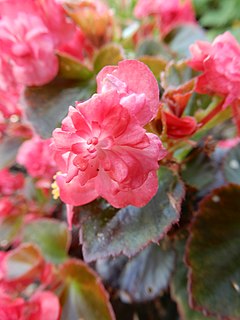 W
WBegonia cucullata, also known as wax begonia and clubed begonia, is a species of the Begoniaceae that is native to South American countries of Argentina, Brazil, Paraguay, and Uruguay. A common garden plant and part of the section Begonia, it was described in 1805 by Carl Ludwig Willdenow (1765–1812). The specific epithet "cucullata" means "resembling a hood" or "hooded".
 W
WBillbergia pyramidalis, commonly known as the flaming torch and foolproof plant, is a species of bromeliad that is native to northern South America and parts of the Caribbean. It was first described by John Sims, and got its current name by John Lindley.
 W
WBrunfelsia latifolia, commonly known as yesterday-today-tomorrow and kiss me quick, is a species of flowering plant in the nightshade family. Endemic to Brazil, it is an evergreen shrub that becomes semi-deciduous in cooler areas and grows up to 1.8 meters in height.
 W
WBrunfelsia pauciflora is a species of flowering plant in the family Solanaceae, the nightshades. It is endemic to Brazil, and it is grown in cultivation. A shrubby perennial plant grown in gardens, its common names include yesterday-today-and-tomorrow, morning-noon-and-night, Kiss Me Quick, and Brazil raintree.
 W
WCaladium bicolor, called Heart of Jesus, is a species in the genus Caladium from Latin America. It is grown as a houseplant for its large, heart or lance-shaped leaves with striking green, white, pink, and red blotching. Hundreds of cultivars are available. It can be planted outside in USDA Hardiness Zone 10 as an ornamental. It is a problematic invasive species in Trinidad and Tobago, Guam, Micronesia, Palau, Hawaii and the Philippines, and naturalized populations can be found in most of the rest of the world's tropics, including Africa, the Indian subcontinent, southeast Asia and Malesia.
 W
WCalamagrostis × acutiflora, called feather reed-grass, is a naturally occurring hybrid species of grass in the genus Calamagrostis, occasionally found in Europe and Asia. Its cultivar 'Karl Foerster' has gained the Royal Horticultural Society's Award of Garden Merit.
 W
WCardiospermum grandiflorum, commonly known as balloon vine, heart pea or heart seed, is a species of climbing plant native to eastern Argentina and Brazil. It was described by Olof Swartz and is in the family Sapindaceae. The species can grow over 10 m (33 ft) long and it has small white flowers. Planted as an ornamental, it has been introduced to all continents except Antarctica, and is a dangerous invasive in places.
 W
WCarex oshimensis, Japanese sedge, is a species in the genus Carex, native to Japan. With its striped foliage, it is widely used as a non‑spreading ground cover. Its cultivar 'Evergold' has gained the Royal Horticultural Society's Award of Garden Merit.
 W
WChenopodium giganteum, also known as tree spinach, is an annual, upright many-branched shrub with a stem diameter of up to 5 cm at the base, that can grow to a height of up to 3 m.
 W
WChrysanthemum × morifolium is a species of perennial plant from family Asteraceae.
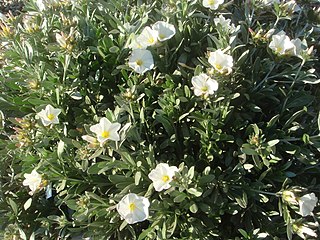 W
WConvolvulus cneorum, the silverbush or shrubby bindweed, is a species of flowering plant in the family Convolvulaceae, which contains many plants described as "bindweed". The Latin specific epithet cneorum is a word of Greek origin referring to a small olive-like plant, possibly a species of Daphne.
 W
WCoprosma repens is a species of flowering shrub or small tree of the genus Coprosma, in the family Rubiaceae, native to New Zealand. Common names include taupata, tree bedstraw, mirror bush, looking-glass bush, New Zealand laurel and shiny leaf.
 W
WFittonia albivenis is a species of flowering plant in the family Acanthaceae, native to the rainforests of Colombia, Peru, Bolivia, Ecuador and northern Brazil. A herbaceous plant, it is notable for its dark green foliage with strongly contrasting white or red veins. It is commonly called nerve plant or mosaic plant. In temperate regions where the temperature falls below 10 °C (50 °F) it must be grown as a houseplant.
 W
WFittonia gigantea is a species of flowering plant in the family Acanthaceae, native to tropical rainforest in South America, mainly Peru.
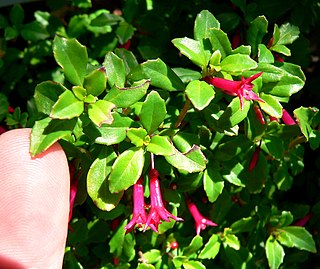 W
WFuchsia microphylla, also known as small leaf fuchsia and small-leaved fuchsia, is a flowering shrub in the family Onagraceae.
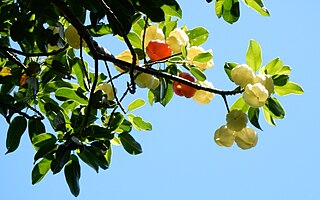 W
WHernandia bivalvis, known variously as the grease nut and cudgerie, is a species of plant in the family Hernandiaceae. It is endemic to Queensland in Australia.
 W
WThis is a list of plant hybrids created intentionally or by chance and exploited commercially in agriculture or horticulture. The hybridization event mechanism is documented where known, along with the authorities who described it.
 W
WKalanchoe longiflora, also known as tugela cliff-kalanchoe or long-flower kalanchoe, is a species of the succulent genus Kalanchoe, in the family Crassulaceae. An obscure shrub native to South Africa, it is known for its multi-coloured foliage and yellow flowers, which bloom in autumn to winter.
 W
WMandevilla sanderi, the Brazilian jasmine, is a vine belonging to the genus Mandevilla. Grown as an ornamental plant, the species is endemic to the State of Rio de Janeiro in Brazil. It is a rapidly growing, creeping, perennial plant, pruning shoots about 60 cm per year.
 W
WNandina domestica commonly known as nandina, heavenly bamboo or sacred bamboo, is a species of flowering plant in the family Berberidaceae, native to eastern Asia from the Himalayas to Japan. It is the only member of the monotypic genus Nandina. It is widely grown in gardens as an ornamental plant since it has a number of cultivars that display bright-red fall foliage in the cool months with attractive new foliage growth in spring. Although a popular ornamental shrub, the berries are toxic to birds, especially towards the end of the winter when other food sources become scarce.
 W
WParodia ottonis, also known as Indian head cactus, is a cactus found in Argentina, Brazil, Paraguay and Uruguay. There are two recognized subspecies. The epithet ottonis honors the German botanist Christoph Friedrich Otto.
 W
WPlant collecting is the acquisition of plant specimens for the purposes of research, cultivation, or as a hobby. Plant specimens may be kept alive, but are more commonly dried and pressed to preserve the quality of the specimen. Plant collecting is an ancient practice with records of a Chinese botanist collecting roses over 5000 years ago.
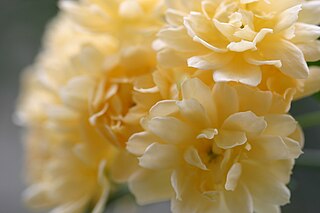 W
WRosa banksiae, common names Lady Banks' rose, or just Banks' rose, is a species of flowering plant in the rose family, native to central and western China, in the provinces of Gansu, Guizhou, Henan, Hubei, Jiangsu, Sichuan and Yunnan, at altitudes of 500–2,200 m (1,640–7,218 ft). The rose is named for Dorothea Lady Banks, the wife of the botanist Sir Joseph Banks.
 W
WRosa chinensis, known commonly as the China rose or Chinese rose, alternatively known as Bengal rose or Bengal Crimson or Bengal Beauty is a member of the genus Rosa native to Southwest China in Guizhou, Hubei, and Sichuan Provinces. The first publication of Rosa chinensis was in 1768 by Nikolaus Joseph von Jacquin in Observationum Botanicarum, 3, p. 7, p. 55.
 W
WSenecio angulatus, also known as creeping groundsel and sometimes as Cape ivy, is a succulent plant from the family Asteraceae of the genus Senecio that is native to South Africa. It is a scrambling and a twining herb that can become an aggressive weed once established, making it an invasive species in some countries. However, it is grown as an ornamental plant for its satiny foliage and sweet-scented flowers.
 W
WSenecio tamoides, also known as Canary creeper, is a climbing member of the genus Senecio of the family Asteraceae that is native to Southern Africa. It is used as an ornamental plant for its showy yellow, daisy-like flowers in autumn.
 W
WSenna pendula, also known as Easter cassia, climbing cassia, winter senna and valamuerto, is a plant of the Fabaceae family with a shrub habit that is native to South America. It used in various parts of the world as an ornamental plant and is an environmental weed in Australia. The flowers of this plant are yellow or greenish yellow and the name pendula means 'pendulous' or 'drooping'.
 W
WStipa lessingiana, called Lessing feather grass, is a species of flowering plant in the genus Stipa, found in steppes from Greece east to Mongolia, including the countries bordering the Black and Caspian Seas, Central Asia, western Siberia, the Altai, and Xinjiang in China. It has gained the Royal Horticultural Society's Award of Garden Merit.
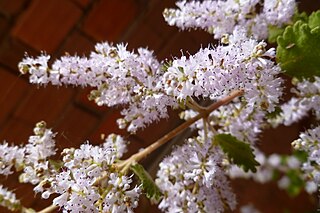 W
WTetradenia riparia is a species of flowering plant native to southern Africa. It belongs in the mint and sage family Lamiaceae. It is occasionally referred to as misty plume bush and is commonly used as a decorative garden plant due to its flowers when in full bloom. Tetradenia means 'four glands' and riparia translates to 'growing on banks of rivers'. This species was first described by botanists (Hochst.) Codd in 1983.